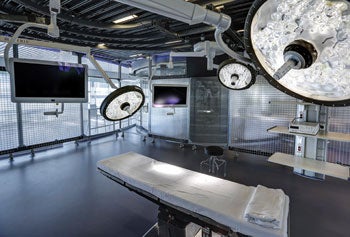Joint OR project explores design and communication
 |
| OR 360 is a joint project exploring the design of the most efficient operating room for trauma care. Photo courtesy of Cedars-Sinai Medical Center |
If time is the difference between life and death for many trauma victims, it only makes sense that care be provided in the most effective way possible. All too often, the goal is easier said than done.
That may change with OR 360, a project headed by Cedars-Sinai Medical Center, Los Angeles, and the U.S. military to design the "operating room of the future" for acute trauma care.
"Our goal is to improve the efficiency and effectiveness of acute trauma care in both civilian and military settings by introducing innovations in communication, technology, workflows and the way medical personnel perform their jobs," says Bruce L. Gewertz, M.D., surgeon-in-chief and chair of the department of surgery, vice president for interventional services and vice dean of academic affairs at Cedars-Sinai Health System.
Exploring design options in the simulation OR is an important element of the research. The use of movable walls and flexible, mobile equipment help to identify how to create the most efficient space possible.
"One of the things we thought about was that we needed to break through some of the preconceptions of OR size and orientation," Gewertz says. "We needed a space that was flexible enough so we could reconfigure the OR's size and equipment to see what effects they had on human performance in the OR."
Because communication, or the lack thereof, is a frequent problem in acute trauma care, MedAware Solutions LLC, a software company in St. Louis, has developed an application for clinicians to use on mobile devices. The company is among several university and private industry collaborators that have contributed to the project.
OR 360 already has resulted in some changes in the ORs at Cedars-Sinai. The medical center has implemented the use of color-coded trauma bays to expedite finding equipment and supplies, whiteboards that display key patient information and pre-briefings among clinical staff before trauma patients arrive.
Asked what the end game is for the project, Gewertz says there is none.
"The project is a work in progress and I hope it never stops," he says. "It's already yielded fruit, it's been well-received in academic circles. I don't think it's ever going to be finished. There's no place to arrive — we're just becoming."




